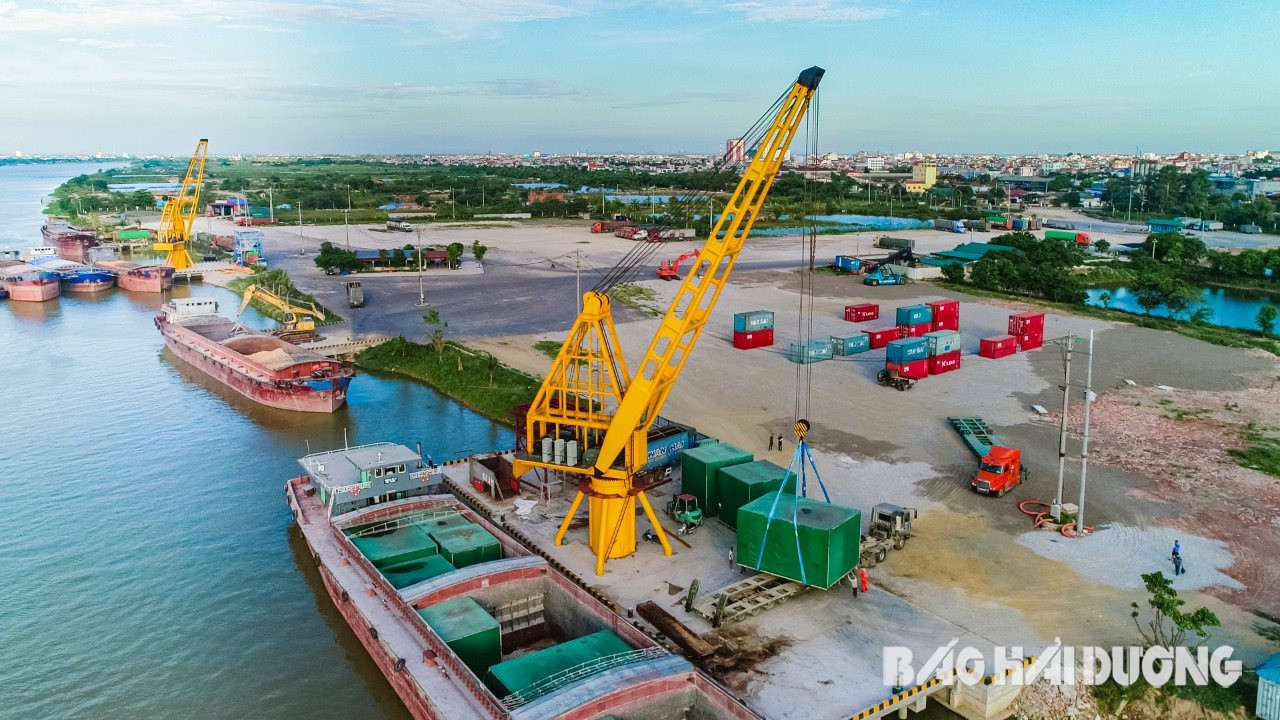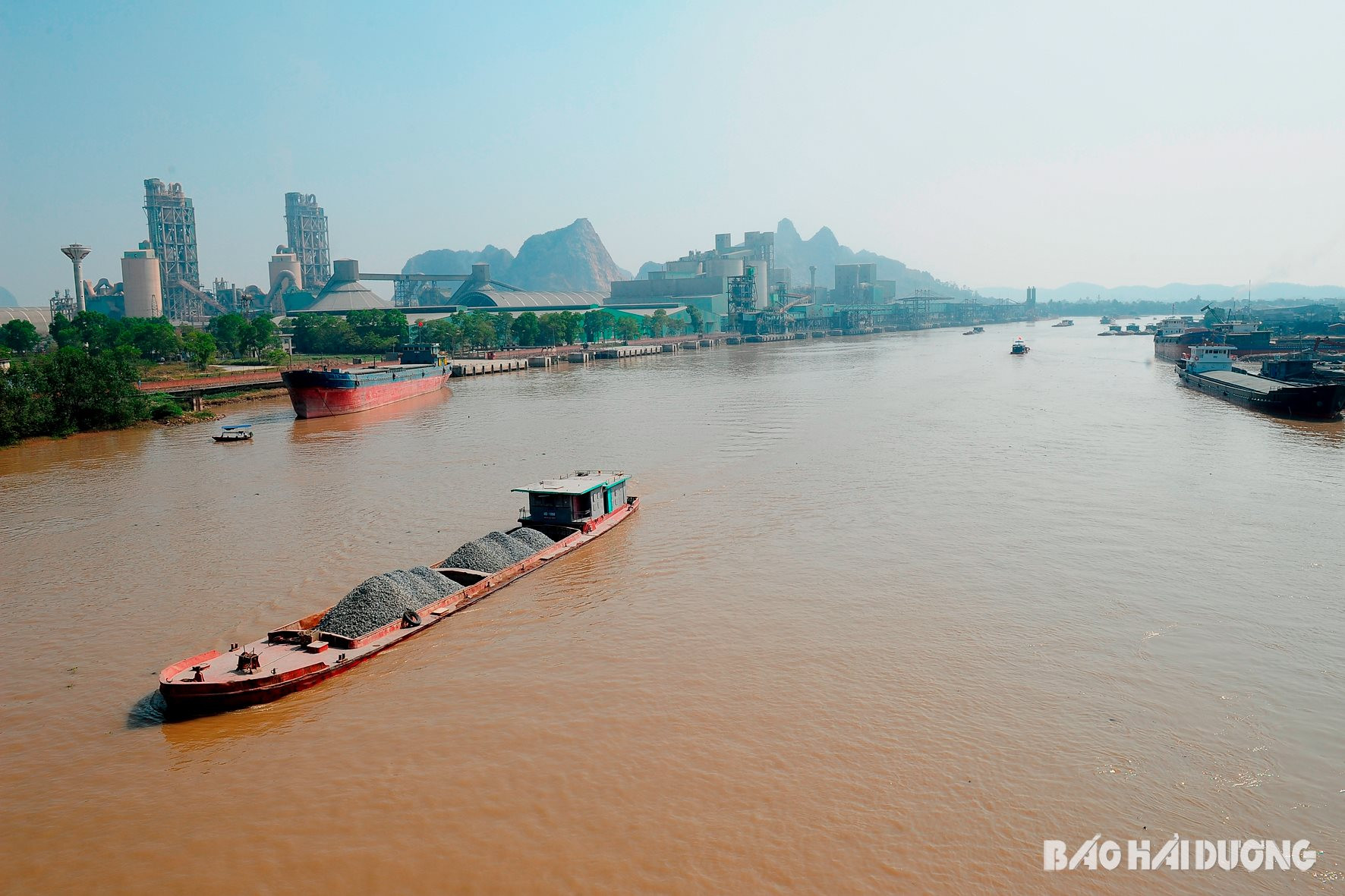The future development orientations of inland waterway transport in Hai Duong promise to open wide "doors" for this industry to fully exploit its potential and advantages, spreading in all directions.

Great potential
One morning at the end of the year, we arrived at Hoang Anh Inland Waterway Port (Hai Duong City). On the river, dozens of boats and barges were anchored. On the shore, cranes and grabs were loading and unloading goods rhythmically. Large and small trucks lined up to enter the port. The sound of engines, conveyor belts, and running vehicles created a bustling, urgent atmosphere.
Mr. Nguyen Van Phong, Deputy Director of Hoang Anh Inland Waterway Port, said that the average monthly loading and unloading output at the port is about 50,000 tons. The peak time of the year is usually from August to February of the following year. The main goods loaded and unloaded at Hoang Anh Port are agricultural products and animal feed such as barley, soybean meal, etc., serving factories in industrial parks and clusters in Hai Duong, Hung Yen, and Hanoi. From this port area, along the Thai Binh River, ships spread out in all directions...
Hai Duong is holding many advantages to develop inland waterway transport. The river system is evenly distributed throughout the localities, connecting localities in the province and regions across the country. The signaling system on the rivers has been relatively complete. The river corridors are fully marked with management boundaries. The characteristics of the rivers are stable hydrogeological conditions, little erosion, gentle flow, no rapids. In particular, Hai Duong has 2 important inland waterway corridors in the Northern region passing through: Route No. 1 (Quang Ninh - Hai Phong - Viet Tri) and Route No. 2 (Quang Ninh - Hai Phong - Ninh Binh).
Improving inland waterway transport capacity

Compared to other modes of transport, inland waterway transport is low cost, especially for long distance transport, transport of oversized, overweight goods, containers and large volume goods. While the investment and maintenance costs of road and railway infrastructure for transport are very high, and construction and expansion face many difficulties, Hai Duong has many rivers running through it, so inland waterway transport has great potential. The development of waterway transport also contributes to reducing pressure on the overloaded road transport network, contributing to reducing traffic accidents.
However, the output and market share of inland waterway transport in Hai Duong is still quite modest at 40-60 million tons/year.
According to Mr. Nguyen Chinh Hanh, Director of Viet Hoa HD Company Limited in Thanh Ha District - a business specializing in inland waterway transport, in the green logistics chain, inland waterway transport is a mode of transport that all countries in the world and Vietnam are striving to build and develop. Taking advantage of the geographical advantages, natural conditions of Hai Duong and the advantages of waterway transport to improve the capacity of inland waterway transport is very necessary.
In the Hai Duong Provincial Planning for the period 2021 - 2030, with a vision to 2050, the orientation for developing the inland waterway network is of interest. The province determines to develop the inland waterway network including the Quang Ninh - Hai Phong - Viet Tri inland waterway route; the Quang Ninh - Ninh Binh route. Develop 30 inland waterway ports in the Kinh Thay - Kinh Mon - Han River port cluster; 4 ports in the Thai Binh River port cluster; Ninh Giang port in the Luoc River port cluster. Develop 6 inland waterway routes managed by the locality. Upgrade, renovate and put into management 17 existing inland waterway ports into the national inland waterway system; develop 12 new inland waterway ports on central rivers...
Mr. Vu Van Tung, Director of the Department of Transport, said that the department has proactively developed the Project "Improving the capacity of inland waterway transport in Hai Duong province" to advise the Provincial People's Committee for approval and implementation. The project focuses on solving the shortcomings of inland waterway transport infrastructure, gradually increasing the clearance of bridges; dredging channels; building port clusters, wharf clusters, routes connecting ports and wharfs with existing and planned roads and railways to develop waterway transport. Gradually completing the modern, synchronous, safe inland waterway infrastructure with high quality transport services, increasing the market share of freight transport, contributing significantly to reducing logistics costs, meeting the requirements of socio-economic development of the province.
Hai Duong currently has 20 inland waterways with a total length of 418.5 km. Of these, 14 rivers and river sections managed by the Central Government are 296.5 km long, including the rivers: Thai Binh, Van Uc, Gua, Mia, Thuong, Luoc, Kinh Thay, Kinh Mon, Mao Khe, Lai Vu, Phi Liet, Song Han, Cau Xe and Lach Tray. 6 rivers managed by the locality with a total length of 122 km include the rivers Sat, Cuu Yen, Dinh Dao, Tu Ky, Cau Xe and Ghe.
Hai Duong has 49 inland waterway ports and 403 inland waterway wharves in operation. Preliminary statistics show that the whole province has about 2,000 inland waterway vehicles, many of which are river-sea vehicles with a load capacity of thousands of tons. Hai Duong has 14 facilities for building, converting and repairing waterway vehicles that have been certified by the Vietnam Register for their capacity to build and repair vehicles with a load capacity of up to 15,000 tons...
HA NGA